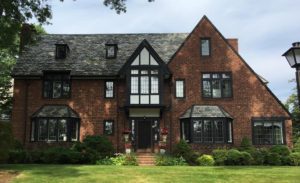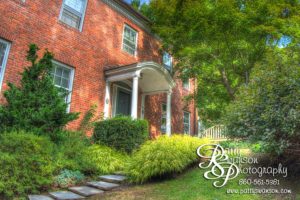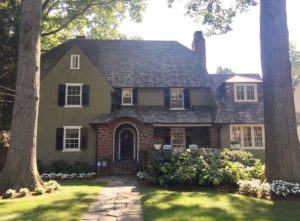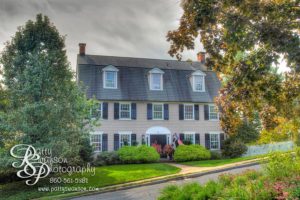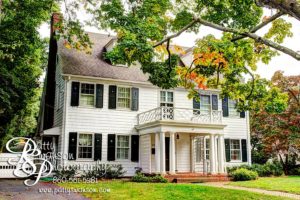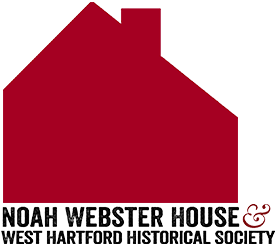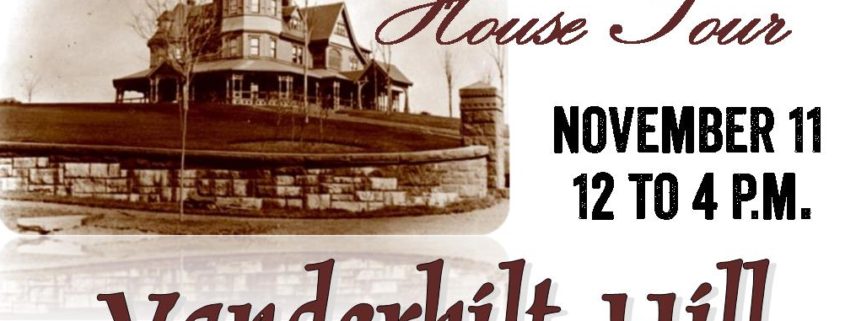
On Sunday, November 11, 2018, from 12-4 p.m., the Noah Webster House & West Hartford Historical Society will host the West Hartford House Tour! “Not just a pretty house,” the purpose of the house tour is to explore the history of West Hartford through its neighborhoods by examining its rich stock of architecture and learning about the people who have made, and continue to make, the town their home.
This year’s house tour will be in the “Vanderbilt Hill” neighborhood. This name hearkens back to a time in the 1800s when the famous Vanderbilt family owned land in West Hartford. Today, Vanderbilt Hill encompasses West Hill Drive and Walbridge Road. The houses on these streets were built in the 1910s and ‘20s for the community’s finest residents. They were considered very upscale and state-of-the-art for their time, were architect designed, and were built for families that could afford hired help.
Cornelius Jeremiah Vanderbilt, the son of the Vanderbilt patriarch called the “Commodore,” started living in West Hartford in 1856. At that time, he lived on the 15-acre “Hamilton Farm” in an 18th-century home built by Rev. Nathan Perkins, the third minister of First Church, West Hartford and tutor to Noah Webster. The house was situated on a hill overlooking Farmington Avenue, and the area quickly became known as Vanderbilt Hill. In 1879, Cornelius Vanderbilt moved the colonial house to make way for a new 30-room mansion fit for the heir of the railroad and steamship fortune. It was made of Portland brownstone and had a 5-story turret and a beautiful veranda. It was one of the finest homes in the Hartford area, but Vanderbilt never actually lived in the mansion.
In 1889, a silk manufacturer name Ira Dimock moved his family into the house. His eldest daughter, Edith, was an artist. While studying in New York City, she met the Ashcan School painter William Glackens. The two were married in 1904 in the Vanderbilt Mansion. The wedding was a lavish affair with guests brought from New York City to West Hartford on a private train. In Christmas of 1907, William Glackens painted the scene he saw from the Vanderbilt Mansion’s veranda. This painting, called “A View of West Hartford,” is now in the collection of the Wadsworth Atheneum Museum of Art.
In 1917, Edith Dimock Glackens and her siblings inherited the Vanderbilt Mansion. Edith’s brother, Stanley K. Dimock, bought his siblings’ shares of the property. He and his business partner Horace R. Grant (the father of former West Hartford Mayor Ellsworth Grant) demolished the mansion in 1918 to make way for a new development. They called this new neighborhood West Hill, and required building specifications that would ensure West Hill’s status as one of the most prestigious in town. There could be only one family houses with garages; the houses had to be designed by an approved architect; the minimum construction cost was $10,000; and all electric wires were to be underground.
Construction on Walbridge Road, which was located at the bottom of Vanderbilt Hill to the east, had begun in the 1910s. These also were architect designed homes, with houses on the west side of the street built to have garages and service access via Hamilton Avenue to the west. These homes were large, with servants’ quarters for live-in staff. These were some of the first houses built for the Hartford elite, who sought to leave the crowded City of Hartford for the more pastoral suburb of West Hartford. Along Farmington Avenue, the first apartment building for wealthy residents, The Packard, was built. Like the houses in the neighborhood, these high-end apartments also came with servants’ quarters!
The 2018 West Hartford House Tour is an exclusive opportunity to see how the other half lived! Guests will tour three private homes on West Hill Drive and three private homes on Walbridge Road. As a bonus, an apartment at The Packard will also be open exclusively for the West Hartford House Tour.
The houses on the West Hartford House Tour are:
• 5 West Hill Drive, 1921.
• 19 West Hill Drive, 1923.
• 41 West Hill Drive, 1926.
• 28 Walbridge Road, 1924.
• 30 Walbridge Road, 1920.
• 58 Walbridge Road, 1911.
• BONUS: The Packard, 749 Farmington Ave., 1920
A reception will be held following the House Tour, from 4-5:30 p.m., at St. John’s Episcopal Church (679 Farmington Ave.). Tickets for the reception are $15 and include hors d’oeuvres by Delicacy Catering and a champagne toast. A cash bar will be available. A tour of the church will be offered at 4:30 p.m. by David Booth Beers. *Online sales for the reception have now ended. If you are interested in the reception, please inquire at the ticket booths (5 West Hill Dr. and 28 Walbridge Rd.) on the day of the event.*
Tickets for the West Hartford House Tour are $30 in advance ($25 for museum members). After Friday, November 9, all tickets are $35. Tickets will be available online until 4 p.m. on Saturday, November 10. After then, tickets will be available on the day of the event beginning at noon at the ticket booths located at 5 West Hill Dr. and 28 Walbridge Rd. For tickets and additional information visit www.noahwebster.yapsody.com.
The West Hartford House Tour will take place on Sunday, November 11, 2018, from 12 to 4 p.m., rain or shine. Advance ticket holders can commence their tour at any of the residences and visit them in any order they wish. Tickets will be available the day of the event outside of 5 West Hill Drive and 28 Walbridge Road. Parking for this event is available on any side street or in the parking lot of St. John’s Church. We ask that you please do not drive or park on West Hill Drive.
The West Hartford House Tour is a fundraiser to benefit the Noah Webster House & West Hartford Historical Society. Thank you to Chef Andrey Kaplun, Hartford Magazine’s Top Chef for 2016, 2017, and 2018, for sponsoring the reception! Silver sponsors are JP Carroll Construction, The Packard, and LeGrand. Additional museum support comes from the Greater Hartford Arts Council and the Hartford Foundation for Public Giving.


